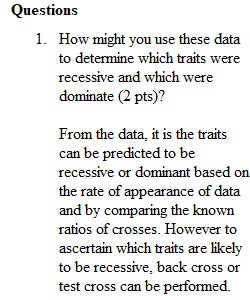


Q WEEK 6 EXPERIMENT ANSWER SHEET Please submit to the Week 6 Experiment dropbox no later than Sunday midnight. SUMMARY OF ACTIVITIES FOR WEEK 6 EXPERIMENT ASSIGNMENT • Experiment 6 Exercise 1 – Monhybrid Crosses • Experiment 6 Exercise 2 – Dihybrid Cross • Experiment 6 Exercise 3 – Inheritance of Human Traits Experiment 6 Exercise 1: Monohybrid Crosses You will be conducting monohybrid crosses using fruit flies. Open in the following website: Fly Lab JS. No date. https://www.sciencecourseware.org/FlyLabJS/ Procedure A. Select a trait to modify from the left side of the page. For the monohybrid crosses, you will only change one trait at a time. B. Select a trait for the male and then click “Select for Mating”. Repeat for the female. C. You are now ready to mate the flies by selecting “Mate” from the menu near the top of the screen. D. You will now analyze your results by clicking on “Analyze”. Click on the box “Ignore Sex of Flies” E. Record the data in the table below. F. Repeat five times to complete the table. Table 1. Results of crosses. Parent Phenotypes Offspring Phenotype Parent 1 Parent 2 # % Wild Type (WT) Forked Bristles 1001 WT 100% WT Questions 1. How might you use these data to determine which traits were recessive and which were dominate (2 pts)? 2. Is it possible to determine the genotype for each cross? If so, how? (3 pts)? Experiment 6 Exercise 2: Dihybrid Cross We will continue to use flies for our crosses, but this time we will examine the inheritance of TWO different traits: body color (gray or black) and wing type (long or vestigial). As with our first crosses, the gray body color is dominant (GG or Gg) over the black body color (gg). And the long wing type is dominant (LL or Ll) over vestigial (ll). Be sure you have reviewed our online Genetics lecture and this week’s reading before proceeding. An example of a dihybrid cross is shown on p 150 in your book. We will cross a gray bodied fly with long wings which has the genotype GGLl with a gray bodied fly with long wings with a genotype of GgLl . Note that even though the phenotypes are the same, the genotypes of the two parents are different. Identify the four possible gametes produced by these two individuals. Note that each gamete must consist of two alleles (G or g and L or l): Parent 1 Parent 2 GGLl GgLl Parent 1 (GGLl) Gametes: _______ ______ _______ _______ (1 pts) Parent 2 (GgLl) Gametes: _______ ______ _______ _______ (1 pts) Create a Punnett square to show the outcome of a cross between these two individuals (GGLl and GgLl) using the gametes you identified above (3 pts). Parent 1 Parent 2 Questions 1. What are the possible F1 genotypes (these must now have four alleles) and their percentages (4 pts)? 2. Recall that GG and Gg individuals are gray bodied, while gg individuals are black bodied and that LL and Li individuals have long wings, while ll individuals have vestigial wings. What are the phenotypes of the resulting offspring and what are the percentages of these phenotypes (2 pts)? Experiment 6 Exercise 3: Inheritance of Human Traits Read over the Inheritance of Human Traits Introduction under the Week 6 Experiment link in our course before beginning. Procedure A. For each of the heritable traits describe below, determine which form you have (dominant form or recessive form). This is your phenotype. B. Record your phenotype information in Table 2 below. Then, enter the possible genotype(s) you have based on your phenotype. C. Answer the questions found following Table 2 below. Description of Heritable Traits Trait Possible Alleles Dominant Form Recessive Form Examples Ear lobes E or e Detached (Free) Attached Hairline W or w Widows peak Straight Widow’s peak Straight Tongue rolling T or t Able to roll Unable to roll Hand folding R or r Right thumb on top Left thumb on top Chin C or c Cleft chin No cleft chin Tongue folding F or f Can fold tongue backwards Cannot fold tongue backwards Thumb H or h Straight thumb (cannot bend backwards) Hitchhiker’s thumb (can bend it backwards) Little Finger B or b Bent inwards Straight Mid-digital hair M or m Hair on fingers No hair on fingers An example is shown as to what should be entered in RED. Please correct the entry for “Ear lobes” based on your personal data. For the Genotypes, please use the letters provided above (8 pts). Table 2. Your phenotypes and genotypes. Trait Phenotype Genotype Ear lobes Unattached OR Detached EE/Ee OR ee Hairline Tongue Rolling Hand Folding Chin Tongue Folding Thumb Little Finger Mid-digital Hair Questions 1. Which traits did you have that were dominant (1 pts)? 2. Which traits did you have that were recessive (1 pts)? 3. What does it mean to be homozygous for a trait? Cite source(s) used (1 pts). 4. What does it mean to be heterozygous for a trait? Cite source(s) used (1 pts). 5. Define genotype and phenotype? Cite source(s) used (1 pts). 6. Which traits do you know for sure that you were homozygous (1 pts)? Week 6 Experiment Grading Rubric Component Expectation Points Experiment 6 Exercise 1 Correctly perform and record the outcome of five monohybrid crosses (Table 1). 5 Demonstrate an understanding of the possible outcomes of monohybrid crosses with respect to genotypes and phenotypes (Questions 1-2). 5 Experiment 6 Exercise 2 Determine the correct parental gametes and conduct a dihybrid cross. 5 Correctly evaluate the outcome of a dihybrid cross (Questions 1-2). 6 Experiment 6 Exercise 3 Correctly recognize one’s phenotype and assigns the correct genotype (Table 2). 8 Demonstrate an understanding of dominant and recessive traits, genotype vs phenotype and homozygous vs heterozygous (Questions 1-6). 6 TOTAL 35 pts
View Related Questions